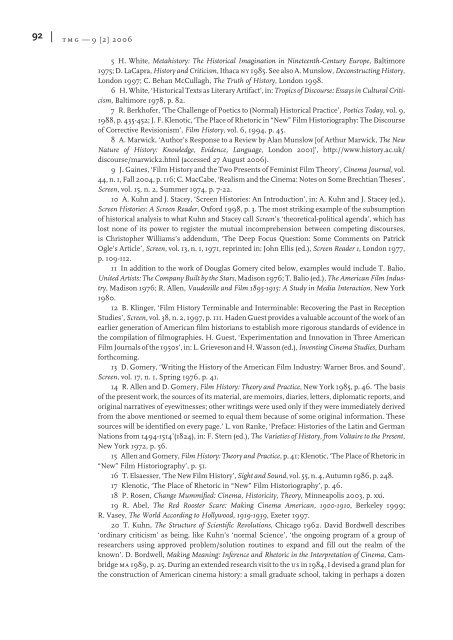Artikel: On the prospect of writing cinema history from below
Artikel: On the prospect of writing cinema history from below
Artikel: On the prospect of writing cinema history from below
You also want an ePaper? Increase the reach of your titles
YUMPU automatically turns print PDFs into web optimized ePapers that Google loves.
92 | tmg — 9 [2] 20065 H. White, Meta<strong>history</strong>: The Historical Imagination in Nineteenth-Century Europe, Baltimore1975; D. LaCapra, History and Criticism, Ithaca ny 1985. See also A. Munslow, Deconstructing History,London 1997; C. Behan McCullagh, The Truth <strong>of</strong> History, London 1998.6 H. White, ‘Historical Texts as Literary Artifact’, in: Tropics <strong>of</strong> Discourse: Essays in Cultural Criticism,Baltimore 1978, p. 82.7 R. Berkh<strong>of</strong>er, ‘The Challenge <strong>of</strong> Poetics to (Normal) Historical Practice’, Poetics Today, vol. 9,1988, p. 435-452; J. F. Klenotic, ‘The Place <strong>of</strong> Rhetoric in “New” Film Historiography: The Discourse<strong>of</strong> Corrective Revisionism’, Film History, vol. 6, 1994, p. 45.8 A. Marwick, ‘Author’s Response to a Review by Alan Munslow [<strong>of</strong> Arthur Marwick, The NewNature <strong>of</strong> History: Knowledge, Evidence, Language, London 2001]’, http://www.<strong>history</strong>.ac.uk/discourse/marwick2.html (accessed 27 August 2006).9 J. Gaines, ‘Film History and <strong>the</strong> Two Presents <strong>of</strong> Feminist Film Theory’, Cinema Journal, vol.44, n. 1, Fall 2004, p. 116; C. MacCabe, ‘Realism and <strong>the</strong> Cinema: Notes on Some Brechtian Theses’,Screen, vol. 15, n. 2, Summer 1974, p. 7-22.10 A. Kuhn and J. Stacey, ‘Screen Histories: An Introduction’, in: A. Kuhn and J. Stacey (ed.),Screen Histories: A Screen Reader, Oxford 1998, p. 3. The most striking example <strong>of</strong> <strong>the</strong> subsumption<strong>of</strong> historical analysis to what Kuhn and Stacey call Screen’s ‘<strong>the</strong>oretical-political agenda’, which haslost none <strong>of</strong> its power to register <strong>the</strong> mutual incomprehension between competing discourses,is Christopher Williams’s addendum, ‘The Deep Focus Question: Some Comments on PatrickOgle’s Article’, Screen, vol. 13, n. 1, 1971, reprinted in: John Ellis (ed.), Screen Reader 1, London 1977,p. 109-112.11 In addition to <strong>the</strong> work <strong>of</strong> Douglas Gomery cited <strong>below</strong>, examples would include T. Balio,United Artists: The Company Built by <strong>the</strong> Stars, Madison 1976; T. Balio (ed.), The American Film Industry,Madison 1976; R. Allen, Vaudeville and Film 1895-1915: A Study in Media Interaction, New York1980.12 B. Klinger, ‘Film History Terminable and Interminable: Recovering <strong>the</strong> Past in ReceptionStudies’, Screen, vol. 38, n. 2, 1997, p. 111. Haden Guest provides a valuable account <strong>of</strong> <strong>the</strong> work <strong>of</strong> anearlier generation <strong>of</strong> American film historians to establish more rigorous standards <strong>of</strong> evidence in<strong>the</strong> compilation <strong>of</strong> filmographies. H. Guest, ‘Experimentation and Innovation in Three AmericanFilm Journals <strong>of</strong> <strong>the</strong> 1950s’, in: L. Grieveson and H. Wasson (ed.), Inventing Cinema Studies, Durhamforthcoming.13 D. Gomery, ‘Writing <strong>the</strong> History <strong>of</strong> <strong>the</strong> American Film Industry: Warner Bros. and Sound’,Screen, vol. 17, n. 1, Spring 1976, p. 41.14 R. Allen and D. Gomery, Film History: Theory and Practice, New York 1985, p. 46. ‘The basis<strong>of</strong> <strong>the</strong> present work, <strong>the</strong> sources <strong>of</strong> its material, are memoirs, diaries, letters, diplomatic reports, andoriginal narratives <strong>of</strong> eyewitnesses; o<strong>the</strong>r <strong>writing</strong>s were used only if <strong>the</strong>y were immediately derived<strong>from</strong> <strong>the</strong> above mentioned or seemed to equal <strong>the</strong>m because <strong>of</strong> some original information. Thesesources will be identified on every page.’ L. von Ranke, ‘Preface: Histories <strong>of</strong> <strong>the</strong> Latin and GermanNations <strong>from</strong> 1494-1514’(1824), in: F. Stern (ed.), The Varieties <strong>of</strong> History, <strong>from</strong> Voltaire to <strong>the</strong> Present,New York 1972, p. 56.15 Allen and Gomery, Film History: Theory and Practice, p. 41; Klenotic, ‘The Place <strong>of</strong> Rhetoric in“New” Film Historiography’, p. 51.16 T. Elsaesser, ‘The New Film History’, Sight and Sound, vol. 55, n. 4, Autumn 1986, p. 248.17 Klenotic, ‘The Place <strong>of</strong> Rhetoric in “New” Film Historiography’, p. 46.18 P. Rosen, Change Mummified: Cinema, Historicity, Theory, Minneapolis 2003, p. xxi.19 R. Abel, The Red Rooster Scare: Making Cinema American, 1900-1910, Berkeley 1999;R. Vasey, The World According to Hollywood, 1919-1939, Exeter 1997.20 T. Kuhn, The Structure <strong>of</strong> Scientific Revolutions, Chicago 1962. David Bordwell describes‘ordinary criticism’ as being, like Kuhn’s ‘normal Science’, ‘<strong>the</strong> ongoing program <strong>of</strong> a group <strong>of</strong>researchers using approved problem/solution routines to expand and fill out <strong>the</strong> realm <strong>of</strong> <strong>the</strong>known’. D. Bordwell, Making Meaning: Inference and Rhetoric in <strong>the</strong> Interpretation <strong>of</strong> Cinema, Cambridgema 1989, p. 25. During an extended research visit to <strong>the</strong> us in 1984, I devised a grand plan for<strong>the</strong> construction <strong>of</strong> American <strong>cinema</strong> <strong>history</strong>: a small graduate school, taking in perhaps a dozen
















